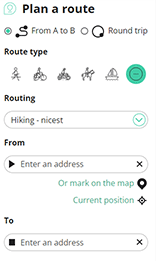

Shortly after leaving thestation of Nismes, we see some very impressive industrial buildings. It is an old tannery (Houben tannery). We are at the foot of the Roche à Lomme.
The tannery, whose buildings are being restored (it is planned to make 16 apartments in it) reached its peak during the 19th century. The tannin was extracted from the bark of the numerous oaks in the region.
For the meaning of "Roche à Lomme", sometimes also spelled "Roche à l' Homme", one could think of a legend relating to a rider who fell off his horse. This is not the case, the so called rock was in fact the southern boundary of the "Pagus Lommensis". This land of Lomme took its name from the river with the same name, tributary of the river Lesse. The Lomme was the north-eastern border of this "country".
From the top of the Roche à Lomme we have a magnificent view over the region. This summit, currently surmounted by a cross, was occupied from the Neolithic period. A square tower, of Roman origin, has long overlooked the site. A Roman garrison occupied the site, allowing surveillance of the road from Saint Quentin and crossing the road between Sambre and Meuse.
Shortly beyond the tannery, the railway rushes into the tunnel des Abannets, who is almost 500 metres long. The river Viroin bypassed the boulder and found the railway at the exit.
The name "Abannets" is derived from the obsolete word "abannir", prohibit. The Prince Bishop of Liege forbade to let cattle graze in this zone full of holes. One of the most famous "Abannets" is the Fondry aux Chiens.
Shortly after the tunnel we see an important quarry on our left. There are many mines for shale, sandstone and limestone in the region. Most of the houses in the area are built in local stone, grey and sometimes pink. Many quarries were exploited for the construction of local houses.
A second tunnel at Nismes?
This project did indeed exist and even got started.
We must not forget that the work of duplicating the track (see Senzeille) did not pass the railway of Nismes because of the war, but also because of the Abannets' natural obstacle. As there was no question of widening the original tunnel, the opted for the same solution as in Senzeille: to dig a new double-track tunnel.
The work began with the digging of a 1.4 m high and 1.2 m wide inspection tunnel. And then that was it. The opening is still visible today, a good twenty meters from the original tunnel, on the Nismes side. According to those who know, the exact length would be about a hundred metres, but it is no longer possible to verify it since the Walloon Region has placed a solid grid there to protect the bats that reside there.

Select one of the most popular activities below or refine your search.
Discover the most beautiful and popular trails in the area, carefully bundled into appropriate selections.
Source: youtube
Select one of the most popular categories below or be inspired by our selections.
Discover the most beautiful and popular attractions in the area, carefully bundled in appropriate selections.
Source: youtube
With RouteYou, it's easy to create your own customised maps. Simply plot your route, add waypoints or nodes, add places of interest and places to eat and drink, and then easily share it with your family and friends.
Route planner

<iframe src="https://plugin.routeyou.com/poiviewer/free/?language=en&params.poi.id=2800107" width="100%" height="600" frameborder="0" allowfullscreen></iframe>
This feature is only available to RouteYou Plus subscribers.
Try 1 month for free and discover the difference! We don't take any payment details, and your trial ends automatically after one month.
© 2006-2025 RouteYou - www.routeyou.com